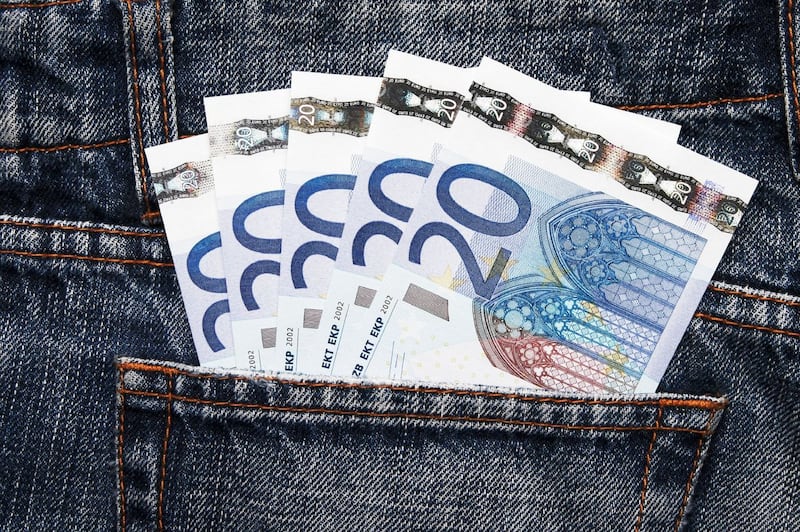What would you say if your local savings institution offered to take your money, put it on deposit, and give you back less when you went to cash it in in 12 months’ time?
“No thank you,” is the likely response. Yet, as inflation starts to inch up, thousands of Irish savers are actually losing money on the “real” value of their deposits. And, if forecasts are correct, they are going to lose more until deposit rates eventually start to rise.
The 'real' value of deposits has diminished, as the purchasing power of people's money decreases in line with inflation
Experts say a typical “real” rate of return on deposits should be about 1 per cent but, as our survey shows, the only product offering such a return in the Irish market today is State Savings offered through An Post – and this is for a 10-year term.
This is because, while inflation might be low – just 0.4 per cent in the year to May 2018 – deposit rates have plummeted to historic lows, barely above zero. As a result, inflation beats many of the returns currently on offer.
So the “real” value of deposits has diminished, as the purchasing power of people’s money decreases in line with inflation.
Moreover, while inflation is ticking upwards, interest rates have, so far, held firm. And that’s not likely to change any time soon as the European Central Bank recently signalled that its key interest rate will remain at zero until after summer 2019.
You could consider leaving your money in a Bank of Ireland demand account, where you can withdraw it any time, but you won't be earning any return either
However, the Central Bank has forecast that inflation will rise to 0.8 per cent by the end of this year, and 0.9 per cent by next.
Not only that, but plenty of economists query whether or not the official rate of inflation is actually an accurate reflection of the price pressures the typical Irish household faces. Would you, for example, say that your household expenses rose by just 0.4 per cent in the year to May?
Glacial rises
While interest rates will undoubtedly start to rise at some point, the rate of increase is likely to be "glacial", says Tom McCabe, global investment strategist with Bank of Ireland.

“June’s ECB meeting pointed towards a first interest rate increase in eight years in 2019,” he said. “This is welcome news for Irish savers, given the average retail deposit rate stands at only 0.17 per cent, less than May’s inflation rate of 0.4 per cent.
“However, the pace of interest rate rises will be almost glacial compared to previous economic cycles, reflecting uncertainties around the path for the global economy and sluggish progress on inflation,” he said, adding that returns for savers will stay low over the next few years and “could even remain negative in real terms once inflation is taken into account”.
Interest rates might move by just 15 or 25 basis points at a time – 0.15-0.25 per cent– not enough perhaps to catch up with inflation.
And, of course, there’s also the other matter that deposit rate moves typically lag actions by the ECB. Some banks may opt not to adjust their deposit rates at all, and if they do, may not pass on the full rate increase.
Despite the record low “returns” on offer, banks remain well funded with deposits. Figures from the Central Bank show that household deposits grew €3.4 billion, or 3.7 per cent, over the year to the end of March 2018 – the 14th quarter of consecutive growth.
So why would banks offer customers a better return when customers will give them their money anyway?
How much am I losing?
The survey clearly shows how important it is to seek out the best deals for your savings. Yes, you may not be actually making very much, but at least you won’t be losing money.
You could consider leaving your money in a Bank of Ireland demand account, where you can withdraw it any time, but you won’t be earning any return either. In fact, as our table shows, you’ll be losing money. If you kept €10,000 in the account since last May, you’ll still be sitting on €10,000. But when you adjust it for inflation, which was 0.4 per cent in the year to May, then the “real” value of your money is just €9,960.

And if you expect, as the Central Bank does, inflation to rise to 0.9 per cent next year, then by next May you could be sitting on just €9,910. So in real terms you’ll have lost €90 by doing nothing with your money, unless the bank hikes up its rates.
And it's not just Bank of Ireland where you risk losing money; demand deposit rates are close to zero at AIB and Ulster Bank, too, while Permanent TSB customers need to make sure they're opting for the "booster bonus" account, which pays out 0.21 per cent a year, compared with just 0.01 per cent for its online account.
While you still risk losing the “real” value of your money, the impact won’t be as bad. However, there is a catch even with this – the bank will only pay you the bonus “0.2 per cent” if you make more than two withdrawals from the account each year.
The best rate available for instant access deposits is KBC’s smart move online account, which is paying out 0.3 per cent. Even then, you are losing money when it is adjusted for inflation.
Term deposits
With term deposits you can expect to do a bit better, but here too, it’s a case of trying to maximise what’s on offer.With KBC’s 12-month deposit account, for example, offering a return of 0.5 per cent a year, you will beat inflation, currently at 0.4 per cent – though not once you pay Dirt.
Avoiding charges of €60 or so a quarter, or €240 a year, will definitely beat any return you might get from a deposit account
And if, as expected, the rate of inflation creeps up, the purchasing power of your deposits will diminish, so that by next May, your €10,000 might be worth just €9,960.
The only real option to beat inflation is to save for the long term. And, even here, the only deposit accounts in Ireland expected to beat inflation over the coming year are the five-year state savings option, paying out 0.98 per cent AER, or the 10-year solidarity bond, both offered by State Savings. This latter is paying out 1.5 per cent AER a year, so even if inflation does more than double to 0.9 per cent next year, you will still be in the black.

Of course if interest rates do start to pick up over the coming years, opting to lock into a five or 10-year rate may not look s as good an option as it does today; but if you did it a few years ago, you might be pleased that you did so.
Pay down debt instead
For those who are mortgage free, and already have enough money on deposit for a rainy day, record low interest rates pose a real challenge, and likely means they'll need to seek out other homes for their money.
For others however, who may have outstanding debt either on a mortgage, car loan, or credit card, once they have reached a certain rainy day cushion, typically up to about six months salary, on deposit, they can put their money to better work by paying down debt.
Consider the case of €10,000 left on deposit. After one year, you’ll have earned just €50 based on the most generous account. And you’ll have to pay Dirt – currently 37 per cent – on this.
What about if you put €4,000 of this against a €5,000 credit card debt (APR 20 per cent), which you’re repaying at the minimum rate, of €100 a month. Doing this means you’ll save yourself a staggering €5,700 in interest payments.
And the other €6,000 you put against your mortgage repayments. Remember, even if you’re on a fixed-rate mortgage, most providers will allow you to overpay by a fixed sum each year, typically about 10 per cent of the monthly repayment.
Consider someone with a €250,000 mortgage on a rate of 3.5 per cent. Putting €6,000 against this loan will actually save them about €11,000 in interest payments over the course of the loan.
You should also consider avoiding bills on your current account by keeping enough money – which might in another environment be worth more by keeping on deposit – to beat charges. After all, avoiding charges of €60 or so a quarter, or €240 a year, will definitely beat any return you might get from a deposit account.












